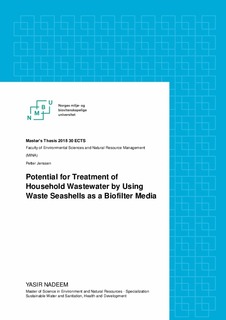| dc.description.abstract | In Norway, approximately 17% of the population is served by decentralized wastewater treatment systems. In these systems, a septic tank only is used, especially in those areas where sea is the final recipient of the treated water. In a septic tank, primary treatment takes place, which is not sufficient for removing pollutants as nutrients, organic matter and pathogens. To improve the quality of the effluent before its discharge, further treatment is required. To remove phosphorus, different kind of phosphorus sorbing materials such as Leca, Filtralite P, limestone, seashells, shell-sand etc. are available in the market. In Frøya Island, most single houses use a decentralized (on-site) wastewater treatment system consisting of a septic tank. Therefore, Frøya municipality is planning to update the existed wastewater treatment system on the entire island by using locally available filter materials. To reduce the investment cost, locally available material is considered used as a filter material. For this purpose three different kinds of sea-shells were investigated through a batch experiment in order to evaluate the phosphorus sorption capacity of each shell type.
Blue-shell, oyster and clam shell samples were collected in the first week of October 2017. Samples were prepared in three sizes (0-2, 2-4 and 4-8 mm) by the crushing and sieving. The batch experiment was performed in the laboratory of the soil section at NMBU. Two experimental set-ups were designed, one for blank analysis in which distilled water was used as a reactant and second for adsorption reactions in which 330 ppm phosphorous solution was used. Phosphorous contents were measured by spectrophotometer and sorbed phosphorus expressed as PO4-P.
The results of blank analysis showed very low values. Therefore, these values were not considered while calculating the final results of adsorption reactions. The batch experiment results represented that oyster shells had maximum sorption capacity and blue shells had minimum sorption capacity such as 7100 mg/kg and 520 mg/kg respectively. Comparatively, clam shells represented more or less similar sorption capacity like oyster shells, i.e. 6650 mg/kg. In addition, smaller sizes (0-2 mm) of all sea-shells showed maximum whereas, larger sizes (4-8 mm) showed minimum sorption capacity. Therefore, on the base of these results, it was concluded that oyster and blue shells have much higher potential for phosphorous removal from domestic wastewater than blue shells.
Based on the batch experiments, it was also calculated that 7.8 m3 of filter material is required for sorbing the phosphorus for 15 years from the wastewater produced by an individual Norwegian house with 5 people. It was also calculated, based on the batch experiments, that if all the septic tank effluents in Frøya filtered by crushed oyster shells, 221 m3 of crushed shells (2-4mm) would be needed per year to remove approximately 81% of the phosphorus. This is less than 15 truck-loads of 18m3/truck. Although, batch experiment results are reliable but they do not mimic the situation in a full scale filter receiving wastewater and, thus, are not sufficient to predict the real sorption and service life of seashells when applied as a filter material in systems receiving domestic wastewater. Batch experiment can only be feasible when comparing the filter materials and ranking them on the base of their phosphorus sorption capacity. Therefore, to more accurately predict the sorption capacity and service life of seashell based filter materials, large scale experiments with real wastewater are required. | nb_NO |

